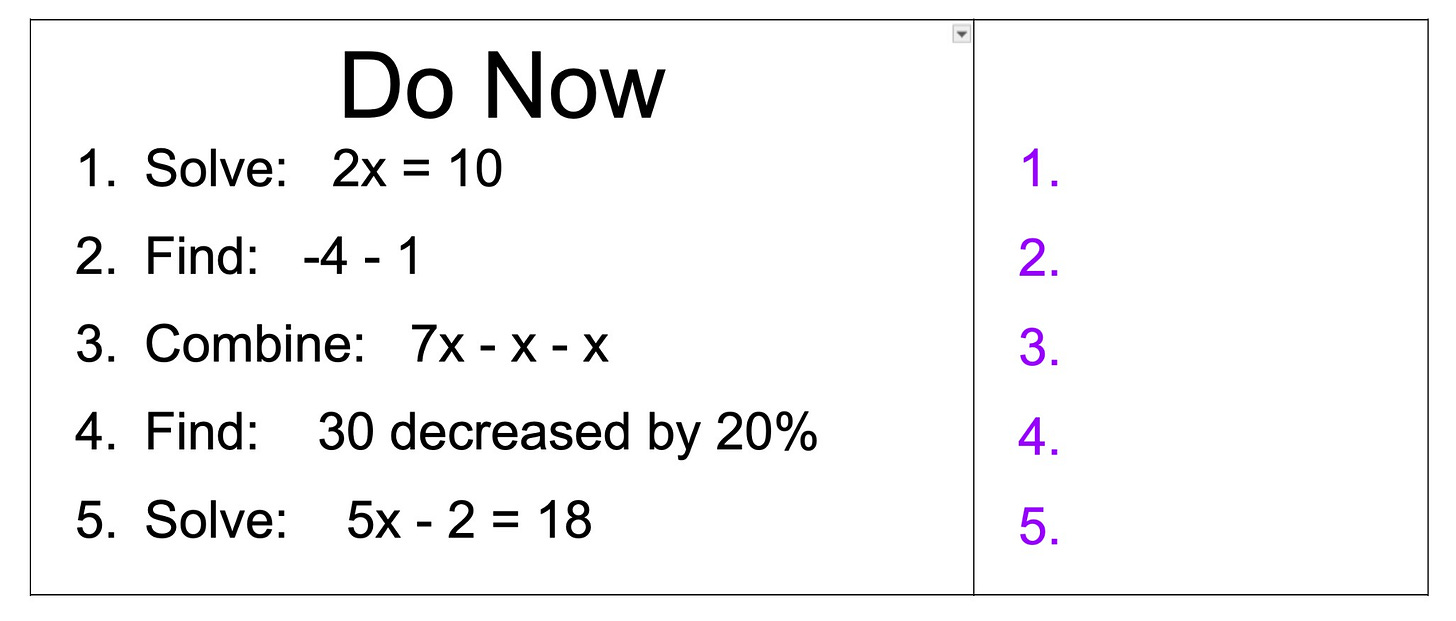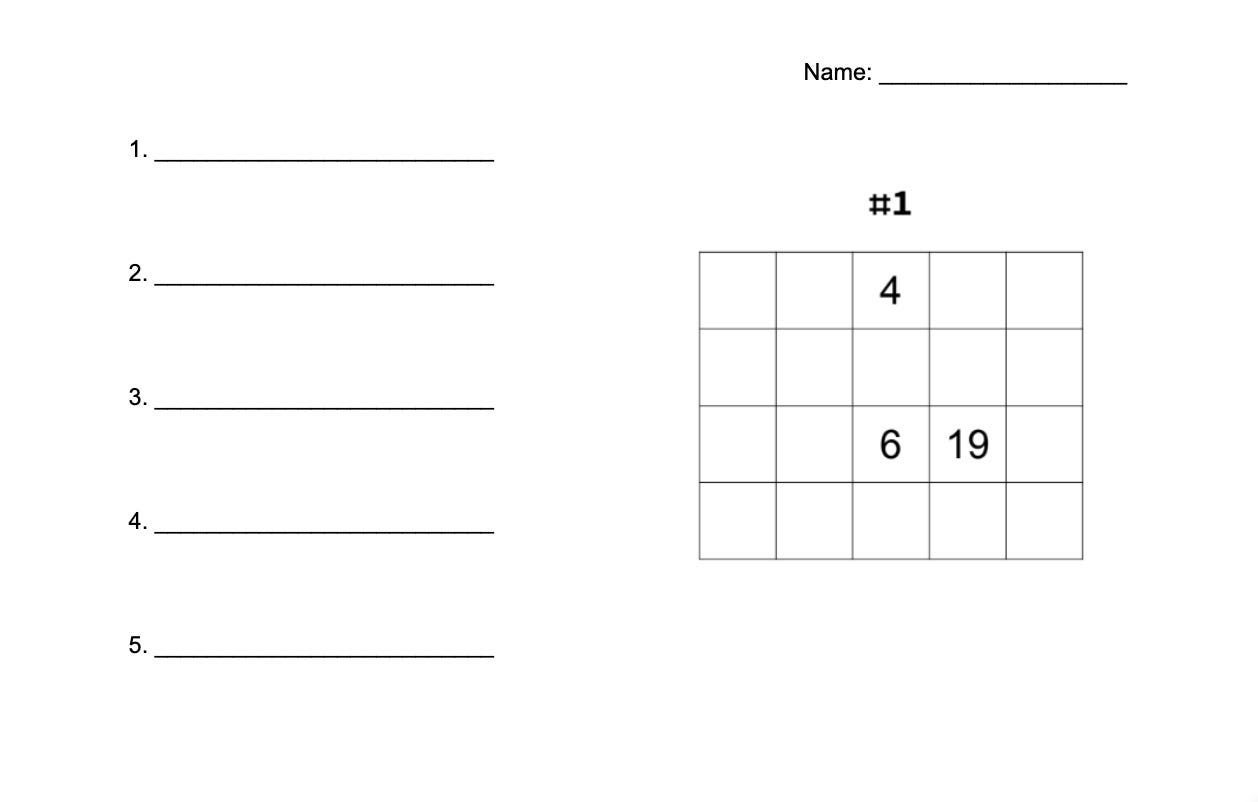Dos and Don'ts of Do Nows
Don't do too much...now
I use a "Do Now" in each class I teach. It's something students do when they first walk in the door, without any directions from me. A Do Now is a requirement at my school, though I think it's generally a decent idea. In the first few minutes of class I need to take attendance and deal with any crises that walk in the door. Students don't all come in at the same time. Having a task ready and a clear routine creates a brisk start to class and keeps students busy while I get the clerical stuff out of the way.
But I think Do Nows are easy to misuse. Here's how I think about Do Nows: These are useful minutes to set the tone for math class. We come in and get started doing math right away. But they are also some of the hardest minutes to use well in class. I don’t try to do too much, and I don’t spend too much time on it.
Don’t Do Too Much
I don't have a good chance to give directions for a Do Now — students don't all come in at the same time, and I'm often busy dealing with some issue in the hallway or a student who comes in a bit escalated. I need the class to do something worthwhile while I'm dealing with things like that. I also have to take attendance, so I don't have as much bandwidth to help students. I want to set the tone that we get right to work in math class, but I want to keep it simple.
The mistake a lot of people make is that they try to use a Do Now to launch their lesson, to get into the main topic of the class. But if the directions aren't totally clear, or the teacher is busy and can't help students, it can mean the lesson gets off to a rough start. Instead, I use the Do Now for a bit of mixed retrieval practice of key things I want students to know really well.
My routine is dead simple. I put five questions on the screen up front. Students pick up a half sheet on their way in and answer five questions that are projected on the board. The questions might look like this (template):
The half-sheet looks like this (template):
The questions aren’t meant to be too hard. That’s the point. When I ask harder questions I want to be able to frame them for students, and have more bandwidth to offer support.
While these aren’t meant to be too hard, they do still involve substantive math. Find a random 7th grader and give them this Do Now. They will often struggle with some of these questions. These are skills that will come up a lot down the road. They’re worth getting good at, worth practicing.
Students answer the questions on the left. If they finish early, they try the puzzle on the right. A few more details about that puzzle and that part of the routine in this footnote.1
Don’t Spend Too Much Time
I aim for three minutes flat, from when students enter the room until we go over the questions. I don't always hit that. If there's some issue I need to address it might take a bit longer. Students come in, I make sure they get started, I deal with anything that needs dealing with, I take attendance. Then I quickly circulate around the room and look at answers to get an impression of where students are. Then we get going with class.
We briefly go over the answers. Briefly! I share the answers (that’s what the purple numbers are for in the image above), maybe add a clarifying note for a problem or two. I resist the urge to go too deep here. It's just not a great time to dive into misconceptions. In general I'm skeptical of the value of going over questions. If I want to address something, I circle back to it afterwards.
For example, when I used this Do Now a bunch of students missed -4 - 1, writing -3. After going over everything else, we circle back to that problem. I give a quick model and explanation, using number lines and a visual. Then I have students grab mini whiteboards. We do two problems like that one — maybe -8 - 2 and -1 - 5. Then I mix in some others. -8 + 2, then a -6 - 1, then 7 - 2, then -3 + -2, then -10 - 4. The goal is to keep students thinking, practicing the specific skill and mixing in some other problems so they can't go on autopilot. Then I’ll ask a similar question the next day and see if students have improved.
It’s tempting to spend lots of time questioning students, trying to lead them to the answers. That can be fine for some situations. But these are review questions, stuff students have learned before. I want to keep it quick and focused. If a lot of students missed a problem, I want to provide a bit of practice to help the learning to stick rather than asking questions and hoping the whole class is listening.
I don’t do this every day, and I never do it for more than one problem. The goal is to keep it short. If students get too many questions wrong I make a note for myself to keep those question types on the Do Now and revisit them in the future.
A Few More Notes
Here are some things I like about this routine:
It’s easy to prep. It takes me a few moments to prep the questions each day. Every two weeks I spend a few minutes copying and paper cutting Do Nows for the next two weeks. I have a planning spreadsheet where I loosely keep track of skills I want to include.
It’s focused and fast. We do it and we get on with the rest of the lesson.
It’s a great time for some retrieval practice. There’s a lot of math I want students to remember. Retrieval practice is key to long-term memory. This isn’t the only place we do retrieval practice, but it’s one solid ingredient.
It’s great for fluency. I want students to be really really good at stuff like 7x - x - x. That’s something small that often trips students up — knowing that x is really 1x. Some practice, well after that unit, helps make that skill automatic for the future.
It’s a great way to check understanding for topics from a while back. I often toss in a question after students haven’t seen it for a while and say to myself, “oh wow, I need to reteach that.” I can check for understanding using the Do Now in a quick, low-stakes way, and use that to make decisions about bigger topics I need to reteach.
It builds confidence at the beginning of class. Students generally do well on these. Getting a few questions right at the start of math class is a good thing.
The puzzle shown is one of Matt Enlow's Number Snakes. The goal is to write the numbers 1 - 20 to make a “snake” where the sequence 1 - 20 is connected in order (orthogonally). I also use KenKens, different Inaba puzzles (Sarah Carter has a good collection here), and other random stuff I find. In general I use one type of puzzle for 4 - 7 weeks. I spend the first few days making sure students understand how that puzzle type works, then I’m pretty hands-off until we switch puzzles.




I print my paper for weekly Do Nows on a pink paper. But every once in awhile I'll print on green and it throws off my students whole week, lol.
I agree with everything you've said here. Having a low-entry task to start each period is essential!
I'm wondering what you have students do with the sheets when they're finished. Do they keep them for review? Recycle them? Do you collect them? I love starting class this way but wonder if students could work the problems on mini-white boards for the same effect. Thanks for your thoughts!